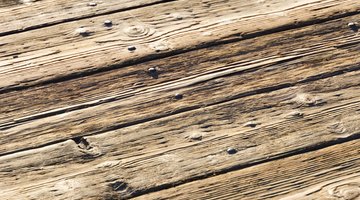Powerwashing Vs. Cleaning With Bleach

Power washing is a fast, easy way to bring back the natural colors of weathered wooden decks, fences and siding. The high-pressure stream of water is powerful enough to actually remove the surface layer of the material toward which you direct it, but it won't remove deep-down stains. You need to treat wood with either oxalic acid or chlorine bleach to get those out. Chlorine bleach also kills mildew and the organisms that cause rot.
The Advantages of Power Washing
A power washer is an electric or gas-powered pump that increases the water pressure from a conventional faucet to anywhere from 1,200 to 4,000 psi, depending on the model. Water under that kind of pressure blows virtually anything off of a wooden or metal surface, including ground-in leaves, mold and even tannins and oils that have leached to the surface. It even restores the color of gray, weathered wood by blowing off the surface coating of dead cells that are responsible for the gray color. Moreover, it accomplishes all this on an average-sized deck or fence in just a few hours.
Cleaning with Bleach
Despite all its advantages, power-washing is an aggressive cleaning method that can splinter, gouge and otherwise damage wood. An alternative is to wash the surface with a commercial wood-brightening detergent -- which usually contains a bleach such as oxalic acid -- then rinse it with a a garden hose. This method is most effective on decks because the wood is horizontal and the bleach can soak in more easily, but it also works on fences and siding. It typically involves a fair amount of scrubbing, and you have to manually remove extraneous debris that the power washer would just blow away.
When Bleaching is Necessary
Blasting wood with a power washer doesn't remove the dark stains caused by contact with metal objects, leaves or other debris, and it won't remove dye stains from berries. You can get iron and tannin stains out with a saturated solution of oxalic acid and water, or you can use a commercial deck brightener that contains oxalic acid. When you need to remove dye, mix a a saturated solution of calcium hypochlorite -- used for maintaining swimming pool water -- and use it to soak the wood. It's stronger than household chlorine bleach. The chlorine solution also kills mold and rot, which is something that power washing doesn't do.
An Effective Combination
Power washing and bleaching aren't really a pair of contrasting options; they make a powerful cleaning combination. A once-over with a power washer reveals the extent of the wood discoloration and mold that you have to treat with bleach. Some power washers even allow you to add bleach to the pressurized water. You should only avoid the power washer when the wood is too fragile to sustain the pressure or the number of fragile items in the vicinity -- such as windows -- makes power washing impractical. Power washing voids the warranty of some types of composite decking materials. Wash those with detergent and water.
References
Writer Bio
Chris Deziel has a bachelor's degree in physics and a master's degree in humanities. Besides having an abiding interest in popular science, Deziel has been active in the building and home design trades since 1975. As a landscape builder, he helped establish two gardening companies.
Photo Credits
- Jupiterimages/Comstock/Getty Images
- Jupiterimages/Comstock/Getty Images
More Articles


